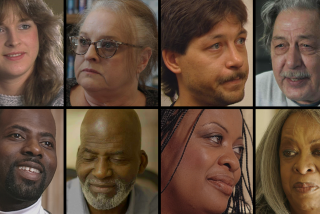TV Preview: Ken Burns documentary looks anew at ‘The Roosevelts’
Whether it’s baseball, jazz or Prohibition, few filmmakers tackle the important subjects of the American past with the depth of Ken Burns.
But when the historical documentarian was contemplating his latest project, he felt it was the right moment to train his lens for the first time on personalities — specifically Theodore, Franklin and Eleanor Roosevelt, who informed not just the decades they led, but the turbulent and dynamic years since.
“There’s something about three extraordinary people who made their mark like this,” Burns said, “and something about treating them as a single family story, with all their failings, without making them heroes at a remove.”
The result is “The Roosevelts,” a 14-hour epic that airs on PBS over seven nights beginning Sept. 14. Spanning more than a century from Theodore’s birth in 1858 to Eleanor’s death in 1962, Burns covers how the family, via two presidents and one first lady, created social programs, overhauled economies and fought wars, all while navigating complex personal struggles.
Though for the most part the miniseries doesn’t seek to break new ground, it does strive for (and succeed at) comprehensiveness. The structure allows the first three episodes to follow Theodore from his upbringing to his days in New York politics, his self-exile to the Dakota Territory and eventually his ascension to the presidency at the age of 42. Franklin — a distant cousin of both Theodore and future wife Eleanor — and others from the Hyde Park branch of the family make brief appearances, with the baton then fully passed to him and Eleanor in the fourth episode.
“Roosevelts” is the first of Burns’ projects in which longtime writing collaborator Geoffrey Ward, a noted historian and author in his own right, appears on camera, complementing voices that include Doris Kearns Goodwin, George Will and Jon Meacham. These interviews are spliced with Burns’ trademark still photos as well as some video footage, along with audio of letters and other archival material read by a variety of well-known voices (Meryl Streep as Eleanor, Edward Herrmann as Franklin and Paul Giamatti as Theodore).
Subtitled “An Intimate History,” the miniseries attempts to offer insight into who the Roosevelts were as people and how they functioned as leaders on the world stage (and, often, how one influenced the other).
It also suggests that their legacy should hardly be relegated to the past. Viewers of “The Roosevelts” may be struck by how many of the issues they grappled with — whether big business’ resistance to reform during Theodore’s administration or isolationist sentiment balking at foreign entanglements during Franklin’s — prefigure much of the modern conversation.
“Faulkner said history is not ‘was’ but ‘is,’ and the experience of the Roosevelts seems especially familiar,” Burns said. “In all of what they’re addressing — the role of government, the tension between ideology and pragmatism — you can hear all of what’s happening today. It is the stuff of now.”
As if underscoring the point, Burns is sitting in a room in Roosevelt House on the Upper East Side of Manhattan. It is in this space dotted with historical artifacts and paintings where Franklin Roosevelt is believed to have practiced the walk to the podium for the Democratic National Convention that rejuvenated his career after he was stricken with polio.
It is also in these two combined homes where Eleanor and her mother-in-law, Sara, with whom she had a famously charged relationship, do battle — a subject Burns covers in the miniseries with no shortage of detail but an abundance of sophistication. Other snippets of personality make their way in as well — Theodore’s colorful pugnacity, for instance, which had him describing a rival as someone with “the backbone of a chocolate éclair.”
Though clearly laudatory of Theodore, Franklin and Eleanor, the miniseries also can take a complicated view of them — not shying from Eleanor’s support of Prohibition, Theodore’s at-times dangerous outlaw approach or Franklin’s seeming abandonment of the social-justice programs as World War II began to percolate.
“We’re very good at saying that, you know, Thomas Jefferson is good and John Adams is bad. Oh, wait a minute, Adams is good and Jefferson is bad,” Burns said. “And what’s wrong in holding them in a kind of tension? We assume there are no heroes because we assume heroism is perfection. But the Greeks defined heroism as a war between strength and weakness. And that’s a hugely important thing we forget.”
Burns and Ward initially conceived of a project based just on Franklin, inspired by Ward’s books on the subject. But as they began developing it in earnest in the mid-2000s, it seemed wrong to them not to include all that preceded it.
To say Burns is prolific is to say that the Roosevelts were a little influential. He is working, in various guises, on miniseries on subjects that include vintage country music, cancer, Jackie Robinson, Vietnam and a few others to boot.
He seems even more of an anomaly than when he came on the scene nearly a quarter-century ago, his slow-burn stories, pans across still photography and understated narration seemingly at odds with the quick-hit 140-character Twitter age.
But he said that he believes the kind of storytelling he practices is timeless.
“I’ve been told all my professional life that we don’t need this many hours. When ‘The Civil War’ came out in 1990, people at the Television Critics Assn. meeting said it’s terrific but no one watching TV has that kind of attention and anyway, Steven Bochco had ‘Cop Rock’ coming out,” he said. “Maybe my rap is an old one, but I feel like meaning accrues in duration. It doesn’t mean we don’t devour YouTube in two minutes. But the relationships and subjects you care about benefit from sustained attention.”
Even the still photographs, he said, allow for a richer brand of storytelling than the video material favored by modern screen entertainment.
“If you have footage of Babe Ruth running around the bases you can talk about him running around the bases,” Burns said. “If you have a photo of him you can talk about everything from his unhappy childhood to how he played baseball.”
Twitter: @ZeitchikLAT
More to Read
The complete guide to home viewing
Get Screen Gab for everything about the TV shows and streaming movies everyone’s talking about.
You may occasionally receive promotional content from the Los Angeles Times.







